An overview of the historic expedition to the ringed planet, which was unprecedented in terms of scope and spectacular sights
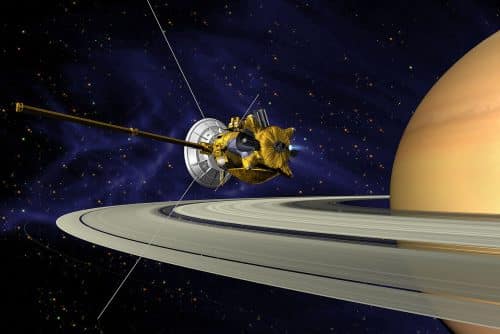
- After 13 years in orbit around Saturn, the Cassini spacecraft ended its mission in September 2017 in a planned dive into the planet's atmosphere.
- During its years of travel, Cassini surveyed Saturn's atmosphere, its rings and moons in unprecedented detail. In 2005, it also launched the Huygens lander to the surface of Titan, Saturn's largest moon.
- Among its many discoveries, Cassini found lakes of liquid methane on the surface of Titan and a buried ocean of liquid water beneath the surface of the moon Enceladus whose waters erupt into space in geysers. Scientists speculate that this subterranean sea is capable of supporting extraterrestrial life.
- Cassini also revealed surprising features in Saturn's rings, such as mountains and "moons" and an effect that colors its atmosphere blue in winter.
On one of the evenings in the future, when the planet Saturn will hang high in the sky, and the night will be bright and dark, observe it through a home telescope. After your soul is filled with the beauty of the planet, search the Internet for images sent by the spacecraft Cassini, launched by the American space agency, NASA. The spacecraft has been orbiting this ringed wonder for the past 13 years. There is no doubt that the pictures will provoke thoughts: how far we have come in our travels, how skilled we have become in interplanetary travel and how extraordinary is the achievement that allowed us to get to know such a distant world like the world of Saturn so closely.
On September 15, 2017, after this article was written, the command was fired that sent the spacecraft orbiting Saturn in a deep dive into its atmosphere. That's how she arrived Her mission is over. The spacecraft burned up in a fireball that no one saw. This is to prevent it from accidentally crashing into one of the moons orbiting Saturn, whose conditions may be suitable for life, and contaminating it.
I started working on the Cassini project at the end of 1990, as the head of the mission's photography team, with colleagues on both sides of the Atlantic Ocean. The task was then nothing more than an idea, a mental vision. I accompanied the design and construction process, watched with my own eyes the launch from Cape Canaveral, Florida on October 15, 1997, waited patiently for the seven year journey to Saturn and won a front row seat when the spacecraft reached its final destination in 2004. Since then, Cassini has revolutionized our world view of Saturn and its surroundings.
No other mission has explored a planetary system as rich as this one Saturn, in such depth and for such a long time. across his moon, titanium, we found seas and lakes of Hydrocarbons and environmental conditions whose complexity rivals that of Earth. We observed the meteorology of the Saturnian atmosphere and witnessed the birth, development and dissipation of giant storms. We discovered new phenomena in the rings surrounding Saturn that testified to the processes that took place in the first stages of the formation of the solar system, including that of the Earth. Like the ancient mapmakers of Earth, we mapped the moons of Saturn for the use of future explorers. We discovered new moons, including a new family of small objects integrated into the rings themselves. And then we made the discovery that to me is the most important in the mission: in the south pole of the moon Enceladus, we came across geysers emanating from an underground ocean that may be Used as a house to extraterrestrial beings. In the far reaches of the solar system, the spacecraft Cassini lived an extraordinarily rewarding life. And now her life and her spectacular scientific journey have come to an end.
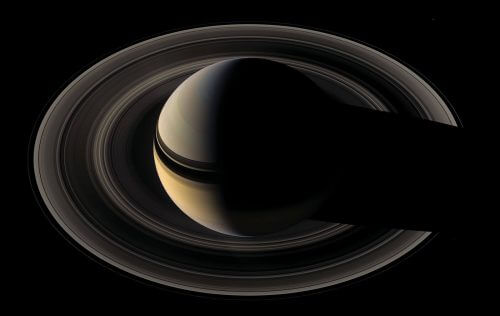
An intimate look
The need for a detailed and extensive examination of the Saturnian system became clear in the early 80s after the two spacecraft ofWager program passed the planet. These two famous events were the opening act in the human exploration journey to Saturn. They gave the planet dimensions and personality, but also left behind questions that demanded answers. Voyager spacecraft discovered a planet whose interior, atmosphere andmagnetosphere His are complex. In its rings, a luminous, vast disk of glacial gravel, the spacecraft recorded signs of the same physical mechanisms that were essential to the formation of the early solar system and similar disks of material around other stars. The passage of the Voyager spacecraft through the interior of the Saturnian system has revealed a world of diverse moons affected by a dynamic set of forces. Although the surface of Titan, Saturn's largest moon, remains hidden behind the thick layer of haze that surrounds it everywhere, it has piqued the curiosity of its observers with hints of the possible existence of a liquid hydrocarbon ocean on its surface. As a whole, it would seem that the Saturn system is a perfect target for in-depth research on processes that, according to the hypothesis, were important in the formation and development of solar systems - whether ours or around other suns - and the dynamics that affect them even today. And it is possible that these processes are even important for understanding the origin of life.
Cassini was an international mission, led by NASA and the European Space Agency, and was designed to be immeasurably better than the Voyager missions in every possible way. The spacecraft, which was about the size of a school bus, was larger than the Voyager spacecraft and carried the most sophisticated scientific equipment ever sent to the outer solar system. Cassini also led the Huygens, a four-meter-diameter, aerodynamically shaped lander carrying six measuring instruments, plummeted to and landed on Titan's surface.
After crossing the solar system, the spacecraft entered orbit around Saturn without incident on July 1, 2004. Its orbit around Saturn was both complicated and precise. The orbits spread around Saturn during the 13 years of the tour like the petals of a flower. The orbit allowed close observation of everything in Saturn's inner system, and the entire orbit was unique in scope, angle and direction. We also had the convenience of changing tracks to dive back in for another look, and in some cases many more looks, at things we discovered earlier.
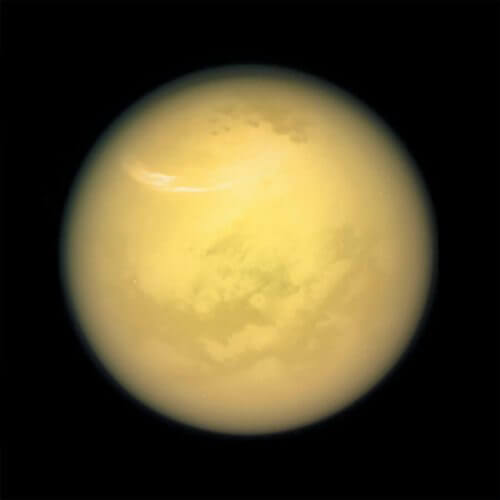
Cassini's long sojourn around Saturn was an essential part of our success. Prolonged monitoring is the only way to detect unexpected processes, such as vulnerability of Meteorites in the rings of Saturn. Moreover, the slow and constant migration of the lunar orbits and the change in the atmosphere as a result of the large seasonal changes in the sunlight, require the collection of observations for as long periods of time as possible. Cassini's official mission was planned to last four years and was supposed to end on June 30, 2008. But the resounding victories of the spacecraft during that time, and the sheer logic of maintaining such a result-producing asset helped convince us to extend the mission. Our successful arguments gave us some extensions, allowing us, for example, to predict the special lighting conditions when equality Between day and night on Saturn, August 2009. The sun's rays at that time illuminated the rings from the side. Any disturbance that peeked above or below the plane of the rings thus cast a long and clear shadow to the eye that betrayed its existence.
Eventually, all of Cassini's orbital operations ended after nearly half a Saturnian year (or, 13 years, two and a half months in Earth terms). We've arrived just after the planet's southern summer solstice and we're finishing up at the northern summer solstice. This time frame allowed us to observe an almost complete seasonal cycle: we saw how the southern hemispheres of Saturn and Titan go from summer to winter and how the northern hemispheres go from winter to summer. There is a sort of cosmic trick to it, but it worked.
The moons
Before the space age, scientists thought that the moons in the outer solar system were geologically dead, featureless lumps of ice. Voyager spacecraft disproved this hypothesis. Cassini's mission was to survey Saturn's flock of satellites and try to understand their histories. In some cases, these stories turned out to be noteworthy.
Take for example the Iapetus. Half of the surface of this moon is white as snow while the surface of the other half is very black - and the reason for this has been a mystery for many years. The high-resolution images taken by Cassini taught us that even on smaller scales the moon is speckled with dark and bright bands. Combining data from the camera and the spacecraft's thermal device allowed us to understand why. The color differences between the two halves as well as the mottled spots were due to a process of thermal emission that takes place only on this moon that rotates slowly around its axis. To begin with, the darker regions heated up and reached a temperature where the ice covering them lifted off and turned into gas. Thus these areas became even darker and warmer. In contrast, the brighter areas were also colder, and therefore served as traps for the ice vapors, which returned and crystallized on their surfaces. Over time, all the ice disappeared from the dark areas and accumulated in the light areas. But how did the process take place over an entire half of the moon? Cassini found that in Iaptus' orbit around Saturn, it passes through a cloud of dark, fine-grained material originating fromPhoebe, one of Saturn's outer and unusual moons. This cloud paints the entire leading half of Iaptus dark and keeps it warm and ice-free. The mystery is solved.
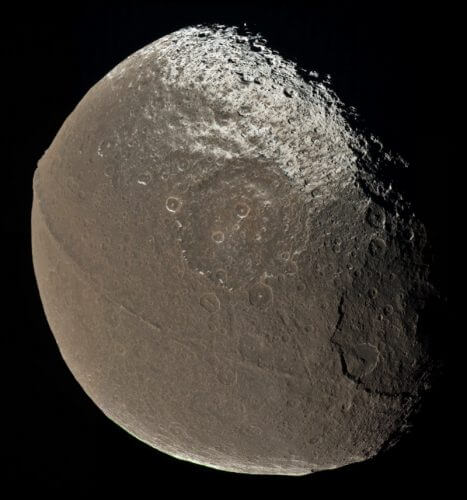
Another unusual moon is Titan. The cameras in the visible light and near-infrared ranges were pre-equipped with means to penetrate Titan's haze cover, and the spacecraft's radar device was optimally adapted to cross the atmosphere without any attenuation. And of course, Huygens' descent in early 2005 through Titan's atmosphere for two and a half hours, during which panoramic photographs, measurements of the atmosphere's composition, transparency, wind and temperature data were collected before the spacecraft landed on the surface of the moon, provided a lot of information. In general, Cassini found in Titan a world that looks like something out of a science fiction story, where the shapes of the landscape and the characteristics of the air are similar to what we know but made of unexpected materials, a place where the sights are familiar but the feeling is different.
In Titan we discovered lakes and seas that are not full of water but bMethane liquid. At the south pole of the moon, the high-resolution camera discovered a liquid body casini that is close in size to that of Lake Ontario (and therefore called by name Ontario Lacos) in the heart of an area that contained similar but smaller fluid reservoirs. Other Cassini instruments later confirmed that Ontario Lakes was indeed full of liquid methane. Since then we have discovered many more liquid methane lakes of various sizes. For some reason they are mostly concentrated in the high northern latitudes. Radar observations revealed rocky and rugged coastlines similar to the coast of a state sort out in the USA. In contrast, the plains in the equatorial region, on which the Huygens lander dropped, are dry and covered with dunes that stretch far and wide around the entire circumference of the moon, occasionally interrupted by higher ground.
The lakes and seas full of organic matter on the surface of Titan have probably raised speculations about the possibility that they contain life. But the surface temperature of Titan is very low: minus 180 degrees Celsius. We would be very surprised to find chemical reactions, similar to those we believe are necessary for the existence of water-based biochemistry, taking place at these temperatures. But if we ever discover true "extraterrestrial" biochemistry, based on methane, it will be an extraordinary historical discovery.
But in my opinion, there is no doubt that Cassini's most important discovery is Enceladus, the icy moon ten times smaller than Titan. The Voyager mission discovered vast stretches of surprisingly smooth plains there. These plains testified to a past characterized by intense internal geological activity, and perhaps even to the existence of a layer of liquid water buried under the ice sheet - and all this on a moon whose dimensions are apparently too small to sustain such processes.
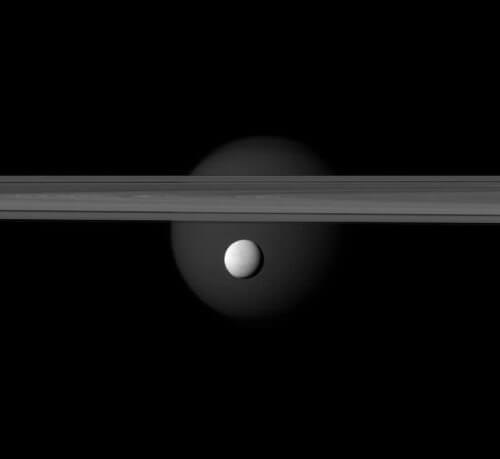
The first hint that Cassini picked up that some activity was taking place on Enceladus came at the very beginning of the mission, in January 2005, when we saw plumes of ice particles ejected from the moon's south pole. Because our images are instantly released to the public, Cassini's fans on the Internet have reacted with excitement. Shortly after, other Cassini instruments confirmed that the transitions were indeed real. Cassini's operators reacted quickly and changed its orbit to allow for a closer look. What we found out about Enceladus in that early period of the mission absolutely amazed us. But only after NASA approved us in 2008 to extend the mission, were we able to devote proper time and resources to examining this fascinating place.
Analysis of the data obtained showed that the tidal forces that Saturn exerts on Enceladus are constantly distorting its shape. This tidal energy generates enough internal heat to create a global ocean up to 45 kilometers deep, buried beneath the outer ice layer that is only a few kilometers thick. More than 100 geysers erupt along four main cracks in the ice of the South Pole, and they are the ones that send out the small ice particles and the water vapor that rises to a height of hundreds of kilometers above the surface. Most of the solid mesa from these transitions falls back to the surface, but a small fraction continues on to form Saturn's large, sparse E ring.
Cassini was able to go through these transformations a dozen times and analyze the materials that make them up. We found that the particles we see in the images, which only a day before were still water droplets in the ocean, carried evidence of large organic molecules and other compounds indicating hydrothermal activity similar to that occurring in the smokestacks in the depths of the oceans on Earth. They also testified that the salinity of the ocean is similar to that of our oceans. The gases that accompanied the solid particles were mainly water vapor, but they also included tiny amounts of simple organic compounds, as well as carbon dioxide and ammonia - all important components for sustaining life and perhaps even for its origin.
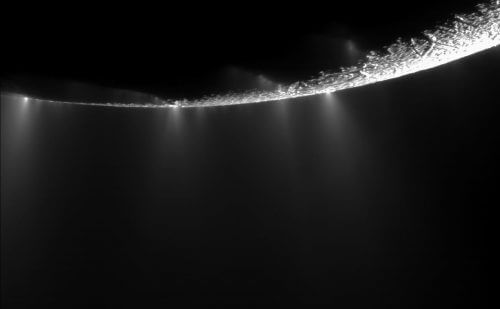
The results obtained from Maxini clearly show that the subsurface environment of Enceladus can sustain biological activity. We must now face some hair-raising questions: Does this small icy moon contain within it another genesis for life in the solar system? Can signs of life be found in his transformations? Do microbes fall like snow on its surface? In no other space body have we found all the signs that we believe are necessary for the existence of life. Today it is the most promising and accessible place in the solar system to search for life. Some of us are so fascinated by this possibility that we are actively engaged in planning space missions to return to Enceladus and find the answers.
the rings
the rings They are undoubtedly what give Saturn its spectacular appearance, and understanding the complicated processes at work in them was one of Cassini's main goals. They are the natural final state of a debris cloud that orbited Saturn, so they are the closest thing to the debris disk that we hypothesize provided the raw materials for our solar system. They are also used as a model forProtostellar discs From which new solar systems are born and even to the billions in the dust storms we callSpiral galaxies. Of all the things we wanted to explore around Saturn, the rings represented the broadest scientific goal, from our neighborhood in space to the edges of the universe.
Using Cassini's instruments, we learned to understand most of the factors that influenced the shape of Saturn's rings. In some places, we found that the gravitational influence of several distant moons disrupted the orbits of the particles that make up the rings and created sharp edges or caused wavy disturbances that progressed outward in a spiral pattern. Elsewhere, where moons are embedded within the rings, gravity has arranged the ring particles into beautiful structures. the moon lest, for example, which is about 30 kilometers in diameter and is located in the space between the rings called Groan gap, did this to the particles around it. In turn, materials from the rings that fell on Penn reshaped his form and made him look like he was wearing a skirt.
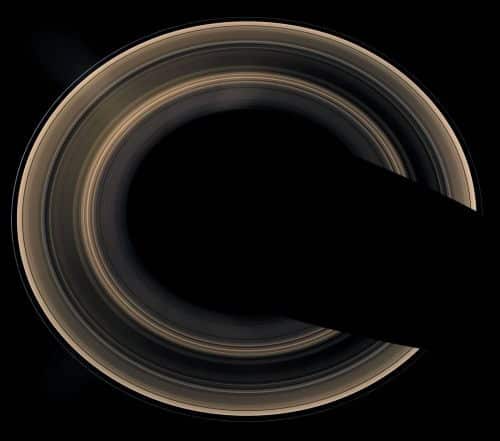
In ring regions where the particles are particularly dense, we discovered self-organization of waves, with wavelengths between 100 meters and hundreds of kilometers, advancing through the disk. These waves reflected sharp discontinuities in particle concentrations. The waves also reacted with each other and with themselves and created patterns of friction that shaped landscapes with a chaotic appearance. The understanding we have acquired about the structure of the rings also includes a delightful confirmation of the prediction that Mark Marley, currently a researcher at NASA's Ames Research Center, and I made in 1993: the acoustic vibrations occurring inside the body of the planet Saturn may also create signs in the rings. In this way, Saturn's rings actually act like a seismograph.
Cassini discovered its most amazing surprises near the equinox in August 2009. Along the sharp outer rim of Saturn's largest ring (B ring) We found a continuous and amazing chain 20,000 kilometers long of pointed silhouettes that betrayed the existence of "ring mountains": waves of particles rising to a height of three kilometers above the plane of the ring. These formations may have formed from extreme compression of ring materials around “monthly” little ones caught in the situation resonance At the edge of the ring like waves of water crashing against a high cliff on the beach.
In another discovery, we saw a very fine compacted coil pattern extending uninterrupted for 19,000 miles across the inner C and D rings. Meticulous detective work conducted by Matt Hedman, now at the University of Idaho, and his colleagues revealed that the impact of comet fragments in the inner rings in 1983 probably pushed all the ring particles in the impact region into inclined orbits. the internal particles hit, that is, they oscillated like twirls, faster than the external particles. Since then, this phenomenon has gone on and wrapped itself more and more tightly until it was embedded in a three-meter-high spiral curling pattern ring. This structure did not exist at all in the days when Voyager spacecraft passed by. We learned that the solar system is a dynamic wonder, and the rings of Saturn, with their varied and flowing forms, serve as an example lesson for the universality of gravity, the various scales on which it operates, and its infinite complexity. No artist could have done better.
the atmosphere
Cassini also studied in great detail the composition and behavior of Saturn's atmosphere and revealed some unexpected features and processes. Its instruments could probe this atmosphere at a wide range of altitudes and reveal its global flow patterns, composition and vertical structure. We found that the atmosphere is divided into broad bands, in the same way that the atmosphere of Jupiter is also divided, although unlike Jupiter, they are less obvious to the eye observing them from the outside due to a thick layer of haze that lies above the upper layer of clouds, consisting ofammonia. When Cassini made measurements below the haze layer in the troposphere, she revealed that the width of the bands varies with latitude: the narrower bands are both darker and coincide with fast jet streams, and wider ones tend to be brighter, and correspond to slower jet streams and may even be stationary with respect to rotation the planet around its axis. In general, Saturn's atmosphere appears to be relatively stable over time. Cassini showed that even the surprising hexagon of jet streams above Saturn's north pole has remained remarkably unchanged since the Voyager spacecraft first saw it. We now know that stability is a common feature of atmospheric systems on the large scale of the giant planets: when there is no solid surface beneath the gas, there is no friction to impede the motion of the atmosphere. When currents start, they persist.
But we were happy to discover that Saturn's atmosphere is not completely indifferent to the change of seasons. Above the winter clouds in the northern hemisphere, Saturn put on an unexpected display when Cassini first arrived: it was blue! Both Voyager spacecraft passes occurred during the equinox season, so no winter images were obtained from them, so the bright color surprised us. Cassini's measurements showed that two phenomena that occur in winter, a lower flux of ultraviolet radiation and the shadow cast by the rings that block sunlight, reduce the rate of outer haze formation. A clearer atmosphere increases the Rayleigh scattering, the process that also makes our sky appear blue, and the absorption of the red light coming from the sun by the methane molecules found in Saturn's atmosphere. The gorgeous blue chips that adorn our winter shots of Saturn look as if someone copied part of the atmosphere of Neptune God of Saturn. Who could have imagined it?
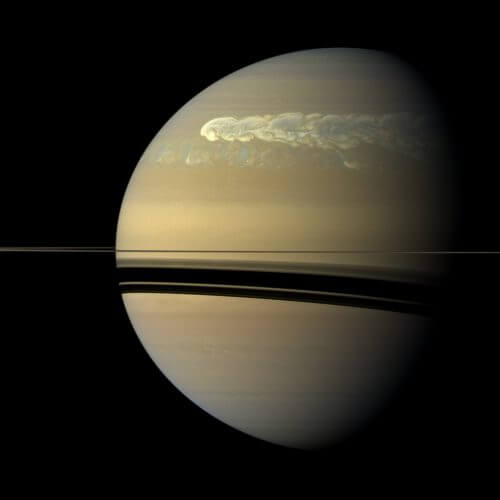
A characteristic feature of Saturn, which has been known for a hundred years, is its tendency, in time spans of decades, for outbreaks of tremendous storms. And so we were moved with joy to advance the face of such a storm that was developing at the end of 2010. For 270 days, we watched a huge, lightning-sending monster, born as a small disturbance in the northern half, then grew, spread clearly around the planet until its tail was swallowed by its head, and which eventually faded. This was another phenomenon that no spacecraft had ever seen before. We hypothesize that water clouds, the main component of Saturn's deepest cloud layer, manage to suppress for decades the aspiration of the lighter hydrogen atmosphere to float and rise upwards. Then, eventually the lift increases and a large burst of flow erupts.
The reviewer of the worlds
From its first drive in 1990 until its dramatic end in September 2017, the Cassini mission has been a major, extraordinarily successful component of the human race's sixty-year journey of discovery beyond our home planet. The historic journey around Saturn has taught us about the complicated workings of an incredibly intriguing and alien planetary system. It has expanded our understanding of the forces that shaped Saturn and its environment, our solar system, and by implication the current shape of other solar and planetary systems throughout the universe.
I doubt in my heart if we will see a mission with Cassini's capabilities returning to Saturn anytime soon. My service on the Cassini mission was a demanding but also very rewarding life's mission of surveying worlds, discovering lands of this era. We hang up now, grateful that the human race will continue to read the story of the Cassini spacecraft for a long time to come.
for further reading

2 תגובות
Titan, the largest moon of Saturn, definitely has an atmosphere, and the pressure there is even greater than on Earth - about 1.6 atmospheres.
I didn't understand how Huygens landed/parachuted, isn't there any air there, so parachutes are out of the question.